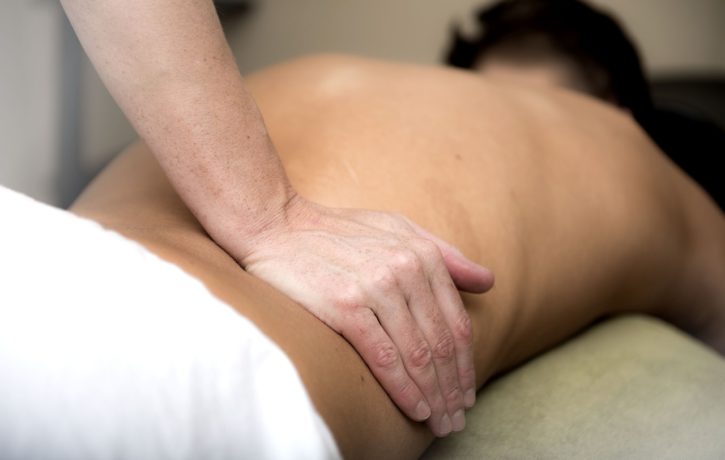Lower Back Pain

Lower back pain is statistically very common. Approximately 85% of the population in the developed world will have an episode of back pain at least once in their adult life.
The cause of such prominence is not because our backs are structurally weak, but that is the general opinion, unfortunately. The term “slipped disc” is something commonly referred to when back pain is talked about yet statistically, only around 5% of lower pain is disc related. The majority of lower back pain will be soft tissue strain, where muscle or ligaments (and/or other connective tissues) are stressed to the point of becoming sore. This can happen with or without a mechanism of injury.
An immediate pain experienced during a movement ( quite often a very benign stimulus, such as picking something up or just bending forwards) will be indicative of a strain in the tissues, purely in the same way that turning on an ankle sprains the ligament/ligaments around the outside of the ankle.
However, some people report pain without a mechanism of injury. Their pain just started on its own, maybe on waking one morning or gradually getting worse over days or weeks with no change in daily routine or habits. How can this be?
Essentially the answer is that our experience of pain is not a measure of tissue damage or harm, but of protection from tissue damage or harm. Pain is horrible/unpleasant/annoying on purpose because if it wasn’t, we could ignore it. The unpleasantness of pain ensures our behaviours are adapted. We move more cautiously, we don’t stand up fully straight, or we limp on the sprained ankle.
With tissue damage, comes healing. If we overload tissues while they are healing, we may compromise the healing process and may slow down our recovery. Healing injured tissues is the priority of our nervous systems and as such we will experience unpleasant sensations if we stress the tissues involved in the injury.
Our muscles become sore after a workout, not because they are damaged but because we have stressed them to the point of fatigue and this now requires a recovery period. Certain movements will, therefore, be sore or painful in order to reduce the stress on the recovering tissues. This is efficient to ensure recovery and reduce the risk of overuse injuries where the body becomes sore through repeated stress.
Our body, especially the lower back is incredibly durable. A recent study stressed the connective tissue and ligaments in the neck of a cadaver to failure. It measured the pressure on the neck by pulling the head forward and down. The pressure was increased until the tissues tore. The resulting failure took 640 lbs of pressure which is incredibly durable when you consider there was no muscle resistance to assist the connective tissues. Now the neck only has to tolerate and support the weight of the head, the lower back has to tolerate the weight of the whole body. Our bodies are incredibly durable and can tolerate huge amounts of stress before they fail yet gentle stress such as sitting for long periods can cause sensitivity because of the potentially long duration.
Long durations of even gentle stretch or pressure will cause sensitivity. Think about the last time you spent a period of time talking on the phone with the handset to your ear. How easy was it to straighten your elbow, can you remember how uncomfortable it was to stretch the bicep in the front of the arm?
Sitting down is equivalent to stress on the tissues in your lower back. If you spend significant time with your back in this position it will be sore when you try to stand up. Most of the time, of course, this feels fine, however, in periods when the tissues are sensitive, then your body just wants you to take it easy through provocative movements and as such, you will experience discomfort or even pain in order to force you to move slower and/or more carefully to reduce the stress on the sensitive bit.
A secondary phenomenon that occurs with any unpleasant sensation is muscle guarding. We tense muscles to resist many unpleasant sensations. Think about the last time you were walking outside on a cold, rainy day. Some of us clench our fists, some bring their shoulders up to their ears, and some clench their jaw. This is muscle tension to resist an unpleasant sensation and it happens unconsciously. Any unpleasant sensations, from cold weather to emotional stress and body pain will drive muscle tension. If the body is already sore, muscle tension will make you sorer and stiffer.
Most of the time these issues will resolve with or without intervention but the concern of most back pain sufferers is that it will not. This anxiety can only add to any physical tension and exacerbate the pain and increase the fear of long-term issues.
Having a full assessment of your back to rule out any concerning pathology is important to put one’s mind at rest and getting the appropriate advice on what activities you should or shouldn’t be doing is imperative to avoid the risk of an episode of lower back pain becoming more prolonged than it needs to be.
If you are interested in having your back assessed then please contact The Body Matters, and ask to see Matthew Oliver.
- The Missing Piece in Wellness? Why Realization Process Offers More Than Mindfulness - 22nd July 2025
- Somatic Healing with the Amnanda Process - 18th July 2025
- Deepen Embodiment: Somatic Breathing with the Realization Process - 20th June 2025
